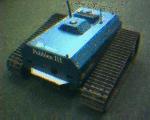Pebbles
Visually-Guided Obstacle Avoidance in Unstructured
Environments
This research has been performed by
Liana Lorigo, advised by
Professors
Rodney A. Brooks and
W. Eric L. Grimson. Funding is
provided by Jet Propulsion Laboratories and an NSF graduate
fellowship.
The current objective is two-fold. The direct application is a system
suitable for a Mars Rover robot, which would move
autonomously upon the rocky, crater-full Martian surface, gathering soil
and atmospheric samples and images. At its mission's completion, the
Rover would return to its lander/spacecraft for its journey back to Earth.
The general computational goal is to push the limits of
existing vision technology, as applied to this problem, thus determining
the modifications, assumptions, and simplifications necessary for a
complete visually-guided robotic system in this real-time, real-world
environment.
A
Modular Obstacle Avoidance System (click for algorithm
description)
This work addresses the problem of designing a mobile robot to avoid
obstacles while traveling in unstructured environments, that is,
environments for which no knowledge of the appearance of the ground or
the locations or appearance of the obstacles is available. An
autonomous obstacle avoidance system has been designed and
implemented. With this system, Pebbles can travel around various
cluttered environments safely. The only sensor used is a single
uncalibrated camera at the front of the robot.
Environments
 Image of Mars surface from Viking 2 lander.
Image of Mars surface from Viking 2 lander.
One goal of this research is the development of a robotic
system to explore the Martian surface by using visual cues to avoid
rocks and craters too large to traverse. Some of the settings in
which the system was tested -- rough outdoor areas and an indoor
room of rocks and gravel -- were motivated by this surface. The
system was also tested in several other indoor settings, such as
lounges, corridors, and offices.
Platform
 The system is housed in the Pebbles III Robot, designed and built
by IS Robotics, Inc.
The system is housed in the Pebbles III Robot, designed and built
by IS Robotics, Inc.
Pebbles is equipped with a Motorola 68332 processor and a Chinon 3mm
camera positioned at the front of the robot 10.5 inches off the
ground. Furthermore, the system uses a visual-processing
hardware system, the CVM (Cheap Vision
Machine), designed by Ian Horswill and Chris Barnhart. The processor is a Texas
Instruments C30 DSP. The vision software is written in C and runs
on the CVM. The system runs a smaller control program, written in L
(a subset of LISP written by Professor Brooks) on the 68332.
Results
Throughout development, the obstacle avoidance system has been tested
cumulatively for over 100 hours and successfully avoids obstacles in a
variety of environments including various carpeted rooms and a rough
simulated Martian surface. Obstacles include rocks, furniture, walls,
and people. Preliminary outdoor trials have also been performed.(Click
on the pictures below for full-size pictures.)






Pebbles traveling in a cluttered environment. (BEWARE: 1053K MPEG)
Click here
for information on other Mars Rover Projects at the MIT AI Lab.
Liana M. Lorigo <liana@ai.mit.edu>
MIT AI Lab
NE43-743
545 Technology Sq.
Cambridge, MA 02139
(617) 253-6095
FAX: (617) 253-5060
Last modified: Sat Apr 6 17:44:35 1996
 Image of Mars surface from Viking 2 lander.
Image of Mars surface from Viking 2 lander. The system is housed in the Pebbles III Robot, designed and built
by
The system is housed in the Pebbles III Robot, designed and built
by 




